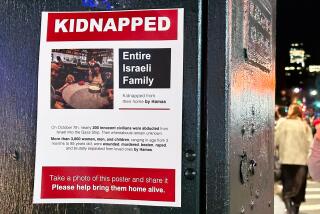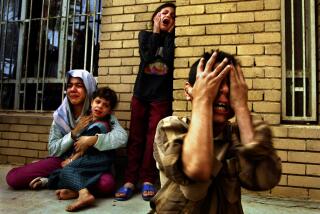Kuwait Children in Exile Sketch Mixture of Hope and Anger, Snakes, Tanks, Planes
- Share via
GENEVA — American warplanes and tanks pound Iraq’s armed forces as the world kicks Iraq out of Kuwait. Or, an Iraqi snake strangles the Persian Gulf emirate.
Such images--drawn or colored by Kuwaiti children--display a curious mixture of anger at Iraqi President Saddam Hussein with an almost naive hope that their country will be freed soon.
Kuwaiti youth aged 4 to 18 composed the drawings in exile in the last few months in the Geneva area, where hundreds of families have stayed or fled to after the Iraqi invasion in August.
Their imaginative artwork was displayed in an exhibition in London and Geneva in November, and the organizers plan to take it to Vienna, Paris and other cities in the next few months.
“He’s no good,” Nora, 4, said of the Iraqi leader. “He killed Kuwaitis. He burned houses in Kuwait. He destroyed cars. He exhausted the petrol.”
But she added hopefully: “Kuwait will be returned.”
Nora had drawn a simple picture of a Kuwaiti child giving flowers to the emir of Kuwait and to President Bush--on whom many of the children seem to pin their hopes.
Other drawings portrayed a strong arm of the United Nations plucking Saddam off the world, or a man with a globe as a head booting an Iraqi soldier out.
One picture has small, white-robed Kuwaitis tying up a giant Saddam, swastika on his officer’s cap, and staking him to the ground while raising Kuwaiti flags once again--reflecting the small but growing Kuwaiti army training to fight Iraq.
Although the U.S. Navy did help escort Kuwaiti oil out of the Gulf during the latter part of the 1980-88 Iran-Iraq war, most Gulf Arabs seemed embarrassed by their friendship with Washington--until Iraq took over Kuwait.
The children in this exhibition made clear, however, that they are friends of any who came to their aid.
Eleven-year-old May depicted children of France, Italy, Germany, the United States, Japan, Turkey and Egypt offering their help and sympathy to a crying Kuwaiti girl.
For every sign of hope, however, there was one of sadness or hatred.
“I’m very angry. Saddam is like a snake. He’s a crazy man. He took my country,” said 12-year-old Shoroq, standing in front of her graphic depiction of a snake squeezing the life out of the map of Kuwait.
Another depicted a dog biting the hand--in the national Kuwaiti colors of red, green, black and white--that fed it. Kuwait had provided billions of dollars to help Iraq in its war with Iran.
Iraqi jets drop bombs while Iraqi soldiers fire on a flaming house in the imagination of 6-year-old Sheikha. Inside the house, tears fall from the cheeks of two tiny children waving flags.
Saddam is depicted variously as a blood-dripping, fanged Dracula, as a lazy man on a settee watching his Kuwait in a bird cage, or as a shark or vacuum cleaner swallowing up all Kuwait’s goods.
One rear view portrays an Iraqi soldier showing “friendship” with his arm around the shoulder of a white-robed Kuwaiti. Behind the Iraqi’s back he holds a sharp dagger.
“Most of the bloody pictures are by the kids who were in Kuwait at the time of the invasion. Those who were outside the country used their imagination based on what they heard,” said banker Mahmood, one of the organizers.
Like others at the Geneva exhibition, he asked that his family name not be revealed for fear of Iraqi reprisals against his relatives.
“Our children are not enjoying their childhood. They don’t play. They sit and talk about how they can play a trick on Saddam, or how to kill him,” said Mahmood, himself a father.
Another of the organizers, 21-year-old Kuwait University student Huda, explained the feeling most of the Kuwaiti exile community seemed to feel toward fighting to drive out Saddam, a sentiment that the children have taken on and understood.
“We don’t want war. But if he refuses to get out of Kuwait, this is the only solution. He refuses every peaceful solution.”
More to Read
Sign up for Essential California
The most important California stories and recommendations in your inbox every morning.
You may occasionally receive promotional content from the Los Angeles Times.










